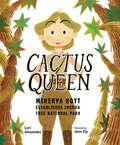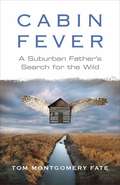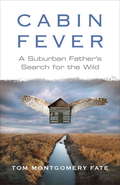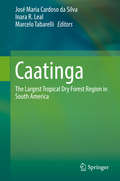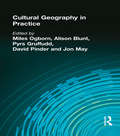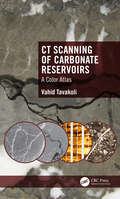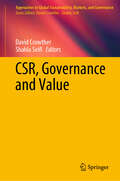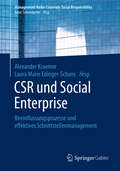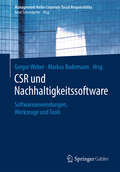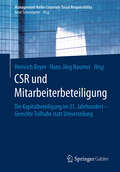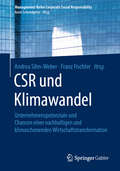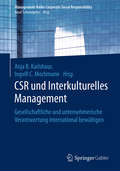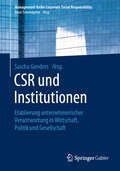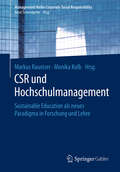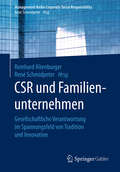- Table View
- List View
Cactus Queen: Minerva Hoyt Establishes Joshua Tree National Park
by Lori AlexanderHow did the Joshua Tree National Park in California come to be? Meet Minerva Hamilton Hoyt, an artist, activist, and environmentalist, whose determination saved the desert and helped to create the park, in this STEAM picture book.Long before she became known as the Cactus Queen, Minerva Hamilton Hoyt found solace in the unexpected beauty of the Mojave Desert in California. She loved the jackrabbits and coyotes, the prickly cacti, and especially the weird, spiky Joshua trees.However, in the 1920s, hardly anyone else felt the same way. The desert was being thoughtlessly destroyed by anyone and everyone. Minerva knew she needed to bring attention to the problem. With the help of her gardening club, taxidermists, and friends, she took the desert east and put its plants and animals on display. The displays were a hit, but Minerva needed to do much more: she wanted to have the desert recognized as a national park. Although she met with President Franklin D. Roosevelt and won him over, Minerva still had to persuade politicians, scientists, teachers, and others to support her cause. And, it worked! Minerva&’s efforts led to what came to be known as Joshua Tree National Park in California, and saved hundreds of thousands of plants and animals. Now, the millions of people who visit each year have learned to love the desert, just as Minerva did.
Cactus Hotel
by Brenda Z. GuibersonIt is another hot day in the desert. Birds and other animals scurry about looking for food. When they get tired, they stop to rest at a giant cactus. It is their hotel in the desert!
Cable Supported Composite Bridges
by Changyu ShaoThis book introduces the latest developments in long-span cable-supported composite cable-stayed bridges, suspension bridges, and mid- and through-type cable-supported composite arch bridges. Based on the engineering application and practice of cable-supported composite bridges, this book systematically expounds the structural systems of these bridge types. It also summarizes the main construction methods, analyzes the mechanical properties of cable-stayed bridges and suspension bridges with composite girders and the influence rule with alternative spans, and proposes the reasonable span range based on economic efficiency. The prospect of using orthotropic composite bridge decks in long-span cable-supported bridges is also analyzed. This book is a valuable reference for both bridge professional technicians and graduate students for research, design and construction.
Cabin Porn: Inside
by Freda MoonLearn to make your own quiet place somewhere with this inspiring journey inside tranquil cabins and handmade homes, from the creators of the wildly popular Cabin Porn phenomenon. Cabin Porn began as an online project created by a group of friends to inspire their own homebuilding. It has grown into a global phenomenon, attracting thousands of submissions from fellow cabin builders and a passionate audience of millions interested in simple, efficient homes and the beauty of nature.Cabin Porn: Inside invites readers into these handmade homes to discover rooms of warmth and simplicity, connected by the universal desire to bring a simple building to life in harmony with the land around it. Each of these tranquil getaways is a lesson in living simply and joyfully.Here you will find hundreds of examples of what makes a cabin: the small details that enable their dwellers to live pleasantly and sustainably, as well as the mistakes and adaptations that reveal what builders must learn while creating their own homes. Perhaps most touching is the evidence that these homes have hosted charming and memorable evenings for the people who worked together to build them. Full of spellbinding spaces of warmth and ingenious simplicity, Cabin Porn: Inside is an invitation to the cabin of your dreams and to the serenity of a simpler life.
Cabin Fever: A Suburban Father's Search for the Wild
by Tom Montgomery FateA modern Walden--if Thoreau had had three kids and a minivan--Cabin Fever is a serious yet irreverent take on living in a cabin in the woods while also living within our high-tech, materialist culture. Try to imagine Thoreau married, with a job, three kids, and a minivan. This is the serious yet irreverent sensibility that suffuses Cabin Fever, as the author seeks to apply the hermit-philosopher's insights to a busy modern life. Tom Montgomery Fate lives in a Chicago suburb, where he is a husband, father, professor, and active member of his community. He also lives in a cabin built with the help of friends in the Michigan woods, where he walks by the river, chops wood, and reads Thoreau by candle light. While he divides his time between suburbia and the cabin, Fate's point is not to draw a line between the two but to ask what each has to say about the other. How do we balance nature (picking blackberries) with technology (tapping BlackBerrys)? What is revealed about human boundaries when a coyote wanders into a Quiznos? Can a cardinal protecting chicks from a hungry cat teach us anything about instincts and parenting? Fate seeks a more attentive, deliberate way of seeing the world and our place in it, not only among the trees and birds but also in the context of our relationships and society. A seasonal nature memoir, Cabin Fever takes readers on a search for the wild both in the woods and within ourselves. Although we are often estranged from nature in our daily lives, Fate shows that we can recover our kinship with the earth and its other inhabitants if we are willing to pay attention. In his exploration of how we are to live "a more deliberate life" amid a high-tech, material world, Fate invites readers into an interrogation of their own lives, and into a new kind of vision: the possibility of enough in a culture of more.
Cabin Fever
by Tom Montgomery FateCabin Fever might be described as a modern Walden, if you can imagine Thoreau married, with a job, three kids, and a minivan. A seasonal memoir written alternately from a little cabin in the Michigan woods and a house in suburban Chicago, the book engages readers in a serious yet irreverent conversation about Thoreau's relevance in the modern age. The author turns Thoreau's immortal statement "I went to the woods because I wished to live deliberately" on its head with the phrase "I got married and had children because I wished to live deliberately." Though Fate spends half his time at the cabin, this is no world-renouncing, back-to-nature paean. Unlike Thoreau during his Walden years, he balances his solitude with full engagement in family and civic life. Fate's writing reflects this balancing of nature and family in stories such as "The Confused Cardinal," in which a male cardinal feeds chicks of another species and leads to a reflection on parenting; "In the Time of Cicadas," which juxtaposes his wife's hysterectomy with the burgeoning fecundity of the seventeen-year cicadas coming out to mate; and in a beautiful essay reminiscent of E. B. White's "Once More to the Lake," in which Fate takes his son to the same cabin his father took him as a child.In his exploration of how we are to live "a more deliberate life" amid a high-tech, materialist culture, Fate invites readers into an interrogation of their own lives, and into a new kind of vision: the possibility of enough in a culture of more.
Caatinga: The Largest Tropical Dry Forest Region in South America
by José Maria Cardoso da Silva Inara R. Leal Marcelo TabarelliThis book provides in-depth information on Caatinga's geographical boundaries and ecological systems, including plants, insects, fishes, amphibians, reptiles, birds, and mammals. It also discusses the major threats to the region's socio-ecological systems and includes chapters on climate change and fast and large-scale land-use changes, as well as slow and small-scale changes, also known as chronic human disturbances. Subsequent chapters address sustainable agriculture, conservation systems, and sustainable development. Lastly, the book proposes 10 major actions that could enable the transformation of Caatinga into a place where people and nature can thrive together. "I consider this book an excellent example of how scientists worldwide can mobilize their efforts to propose sound solutions for one of the biggest challenges of modern times, i. e. , how to protect the world's natural ecosystems while improving human well-being. I am sure this book will inspire more research and conservation action in the region and perhaps encourage other groups of scientists to produce similar syntheses about their regions. " Russell Mittermeier, Ph. D. Executive Vice-Chair, Conservation International
CULTURAL GEOGRAPHY IN PRACTICE
by Miles Ogborn Alison Blunt David Pinder Pyrs GruffuddCultural Geography in Practice provides an innovative and accessible approach to the sources, theories and methods of cultural geography. Written by an international team of prominent cultural geographers, all of whom are experienced researchers, this book is a fully illustrated guide to methodological approaches in cultural geography. In order to demonstrate the practice of cultural geography each chapter combines the following features:·Practical instruction in using one of the main methods of cultural geography (e.g. interviewing, interpreting texts and visual images, participatory methods)·An overview of a key area of concern in cultural geography (e.g. the body, national identity, empire, marginality)·A nuts and bolts description of the actual application of the theories and methods within a piece of researchWith the addition of boxed definitions of key concepts and descriptions of research projects by students who devised and undertook them, Cultural Geography in Practice is an essential manual of research practice for both undergraduate and graduate geography students.
CT Scanning of Carbonate Reservoirs: A Color Atlas
by Vahid TavakoliThe Computed Tomography (CT) scanning of carbonate reservoirs is a non-destructive method used to obtain valuable information from reservoir rocks. This concise book covers all aspects of CT image analysis and their interpretation. It is focused on the CT scanned images and the data gathered from various carbonate reservoirs with different ages, from Paleozoic to Tertiary, and with different textures, degrees of heterogeneity, facies types, diagenetic impacts, fossil contents, sedimentary structures, reservoir quality, and fracturing. Numerous high-resolution images illustrate various aspects of carbonate rock properties and are suitable for analysis by both professionals and students. FEATURES Provides the first specialized book about core CT scanned image descriptions and explanations Contains supplementary data from various sources, such as image logs, cores, and thin section photos and petrophysical measurements Includes original CT images from different reservoirs Covers both research and industrial aspects of core CT scanning and is useful for comparing CT scanned images Uses original images and reservoir data gathered by the author This book can be used by professionals working in the oil and gas industry, researchers and academics studying petroleum-related disciplines, and students taking courses in petroleum geology and reservoir engineering. It can also be used in a range of related sciences, such as sedimentology, soil sciences, paleontology, petrology, engineering geology, study of porous materials, and hydrogeology.
CSR, Governance and Value (Approaches to Global Sustainability, Markets, and Governance)
by David Crowther Shahla SeifiThis book presents the changing face of social responsibility, showing how it has grown to encompass governance, becoming a vital part of various aspects of human endeavor. From businesses to politics to justice systems, Corporate Social Responsibility (CSR) has expanded its reach, touching every sphere of human activity. What is particularly interesting is how governance failures have highlighted its importance in addressing the economic and social challenges that many organizations face today. This shift has led to a reevaluation of the traditional triple bottom line approach, with governance and supplier behavior emerging as critical components of CSR. Stakeholders, especially consumers, are now actively monitoring companies, influencing their decisions and ultimately impacting their bottom line. The book critically examines these transformations in business behavior through the lenses of governance and CSR, questioning the need for redefining key concepts in the field. Authored by scholars from diverse global backgrounds, it blends theoretical insights with practical considerations, offering a comprehensive exploration of the evolving landscape. Drawing from the tradition of the Social Responsibility Research Network, known for its inclusive approach and emphasis on interdisciplinary research, the book presents varied perspectives and solutions derived from shared best practices. Based on contributions from the Network's recent conference, this book showcases both the unity and diversity of ideas within the field. By examining both theory and practice, it aims to deepen our understanding of these evolving trends and their implications for defining key concepts in social responsibility and governance.
CSR und Social Enterprise: Beeinflussungsprozesse und effektives Schnittstellenmanagement (Management-Reihe Corporate Social Responsibility)
by Alexander Kraemer Laura Marie Edinger-SchonsLernen Sie in diesem Buch mehr über einen besonderen Zugang zu Corporate Social Responsibility: Das Social EnterpriseIn diesem Band „CSR und Social Enterprise - Beeinflussungsprozesse und effektives Schnittstellenmanagement“ stellen die Herausgeber Alexander Kraemer und Laura Marie Edinger-Schons fundiert und praxisnah einen besonderen Zugang zu Corporate Social Responsibility (CSR) vor: Das Social Enterprise. In der heutigen Zeit stellt die Gesellschaft viele neue Anforderungen an Unternehmen. Jeder Betrieb reagiert unterschiedlich auf die geänderten Voraussetzungen. Immer mehr von ihnen richten eigene CSR-Abteilungen ein, die eher soziale als profitorientierte Zielsetzungen verfolgen. Weiterhin kooperieren sie stärker mit sogenannten Social Enterprises. Hierunter versteht man sich selbst finanzierende Geschäftsmodelle mit folgenden Zielsetzungen:a) Lösung sozialer oder ökologischer Problemeb) Gründen von Stiftungen mit sozialer ZielsetzungAußerdem werden in diesem Corporate-Social Responsibility-Buch erstmalig Unternehmensverantwortung und Sozialunternehmertum miteinander in Verbindung gebracht.Anschauliche Ansätze sowie Strategien aus Wissenschaft und PraxisZahlreiche Autoren beleuchten aus der Perspektive von Wissenschaft und Praxis anschaulich, wie in diesen Kooperationen gegenseitige Beeinflussungsprozesse stattfinden. Denn dadurch verändert sich nicht selten die traditionelle Art zu wirtschaften hin zu mehr Nachhaltigkeit. Damit diese Prozesse aber auch zu einer positiven Veränderung führen, müssen Schnittstellen effektiv gestaltet und Kulturunterschiede überwunden werden. Deshalb geht es in diesem Corporate-Social Responsibility-Buch um folgende Inhalte:Teil I - Grundlagen zur Schnittstelle: CSR und Social EnterpriseTeil II - Effektives SchnittstellenelementTeil III - Best Practice Case StudiesTeil IV - AusblickAlexander Kraemer und Laura-Marie Edinger-Schons sind davon überzeugt, dass die Zusammenarbeit zwischen den verschiedenen Akteuren im Social Business entscheidende Beiträge zur Lösung konkreter sozialer und ökologischer Herausforderungen leisten kann. Mit diesem Band möchten sie einen Beitrag zur aktuellen Diskussion um diese Themen und Fragestellungen leisten.
CSR und Nachhaltigkeitssoftware: Softwareanwendungen, Werkzeuge und Tools (Management-Reihe Corporate Social Responsibility)
by Gregor Weber Markus BodemannUnternehmen müssen heute Antworten auf ökonomische, soziale und ökologische Herausforderungen finden, wenn sie langfristig Erfolg haben wollen. Aber wie lässt sich Corporate Social Responsibility (CSR) nach dem Grundsatz „mehr Ökonomie durch Ökologie“ managen? Welche Hilfsmittel stehen Unternehmen und Organisationen dafür zur Verfügung? Das Buch konzentriert sich auf Software, Instrumente und Tools für das Nachhaltigkeitsmanagement und schließt damit eine wichtige Lücke.Im ersten Teil zeigen die Autoren, welche Bedeutung Nachhaltigkeit, Nachhaltigkeitsmanagement und Nachhaltigkeitsberichterstattung für Unternehmen und Organisationen haben und was die am Markt gängigen Softwaretools bieten. Hier kommen nicht nur Wissenschaftler zu Wort, sondern auch Vertreter politischer Organisationen wie der Vereinten Nationen oder des Rates für Nachhaltige Entwicklung der Bundesregierung. Im mittleren Teil stellen führende Anbieter von Software für Nachhaltigkeitsmanagement ihre Anwendungen vor. Dabei liefern sie nicht nur einen Überblick über die Funktionalitäten, sondern beschreiben auch Zusatzbausteine und Synergieeffekte, die sich aus der Kombination mit anderen Systemen ergeben. Screenshots helfen Lesern, einen Einblick in Aufbau und Struktur der Software zu gewinnen. Berichte von Anwendern aus Unternehmen und Organisation runden den Überblick über die Tools ab.Das Buch richtet sich an Verantwortliche in Unternehmen und Organisationen, die wissen wollen, wie Nachhaltigkeitsmanagement effektiv betrieben werden kann.
CSR und Mitarbeiterbeteiligung: Die Kapitalbeteiligung Im 21. Jahrhundert - Gerechte Teilhabe Statt Umverteilung (Management-Reihe Corporate Social Responsibility)
by Heinrich Beyer Hans-Jörg Naumer„Die Armen werden immer ärmer, die Reichen immer reicher“ – das ist wohl die Kurzformel einer der drängendsten Debatten unserer Zeit. Dabei kennt diese Debatte scheinbar nur eine Antwort: Umverteilung. Mit „Gerechte Teilhabe statt Umverteilung“ gehen die Autoren dieses Buches programmatisch bewusst einen anderen Weg: Sie wollen Teilhabe durch Kapitalbeteiligung.Ihr gesamtwirtschaftlicher und gesellschaftlicher Blick auf die Mitarbeiterbeteiligung als Form gerechter Teilhabe führt daher zu einem radikalen neuen Ansatz zu den Themen „Kapital“ und „Arbeit“. 150 Jahre nach Erscheinen von „Das Kapital“ - Karl Marx, drei Jahre nach Erscheinen von „Das Kapital im 21. Jahrhundert“ -Thomas Piketty, aber auch beinahe 75 Jahre nach der „Freiburger Denkschrift“ - Walter Eucken et al., die konstitutiv für unsere Wirtschaftsordnung ist, gehen die Autoren daran, die Brücke zwischen Kapital und Arbeit zu schlagen, und rollen damit die Debatte um Arm und Reich lösungsorientiert neu auf.Vermögensbildung durch Kapitalbeteiligung stellt den zentralen Inhalt des Buches dar. Einen Schwerpunkt dabei bildet die Motivation, Kapitalbeteiligung als Antwort auf den technologischen Wandel in der Wirtschaft zu gestalten. Dafür wird auch das „Bedingungslose Grundeinkommen für die Industrie 4.0“ aus einer völlig neuen Perspektive diskutiert und „Teilhaberfonds“ als Möglichkeit, Eigentumsrechte mit risikomindernder Diversifikation zu verbinden, in die Diskussion eingeführt. Das Buch ist dabei auch ein Anwenderbuch: Es führt keine Diskussion im Elfenbeinturm, sondern unterbreitet Vorschläge sowohl für die betriebliche als auch die politische Praxis. Fundiert, aber dennoch leicht lesbar, wendet es sich an eine gesellschaftspolitisch interessierte Zielgruppe in Politik, Wirtschaft und Unternehmen.
CSR und Künstliche Intelligenz (Management-Reihe Corporate Social Responsibility)
by René Schmidpeter Reinhard AltenburgerIn diesem Buch werden neben Impulsen aus der aktuellen wissenschaftlichen Diskussion Good Practice Cases von Unternehmen im Umgang mit den besonderen Herausforderungen durch den Einsatz von Künstlicher Intelligenz (KI) vorgestellt.Die vielfältigen Herangehensweisen an die Anforderungen, welche mit dem Einsatz von Künstlicher Intelligenz verbunden sind, sollen Anregungen für Unternehmen und Wissenschaft in diesem häufig sehr kontrovers diskutierten Feld bieten. Ein besonderes Gewicht wird auf die Chancen durch KI für Unternehmen aus unterschiedlichen Branchen gelegt. Die Auseinandersetzung mit dem Spannungsfeld KI und neue Herausforderungen der CSR bietet strategische Möglichkeiten, aber auch Innovationschancen. Die aktive Einbindung von Stakeholdern in den Gestaltungsprozess dient auch dem Aufbau von Vertrauen bei Kunden und der Öffentlichkeit und leistet somit einen Beitrag zu Innovation und Akzeptanz von KI.Der Beitrag Künstliche Intelligenz & die Zukunft von Arbeit wird unter der Creative Commons Namensnennung 4.0 International Lizenz veröffentlicht.
CSR und Kommunikation: Unternehmerische Verantwortung Uberzeugend Vermitteln (Management-Reihe Corporate Social Responsibility)
by Peter HeinrichDiese aktualisierte und überarbeitete 2. Auflage liefert einen fundierten, praxisbezogenen Überblick über die Kommunikationsinstrumente und -möglichkeiten sowie den Planungsprozess im Bereich CSR. Es ist ein Ideenkatalog und vermittelt zugleich auch das wissenschaftliche Hintergrundwissen. 20 Praxisbeiträge aus verschiedenen Branchen zeigen, wie die CSR-Kommunikation wirksam angewendet wird. Viele Unternehmen engagieren sich heute gesellschaftlich und übernehmen Verantwortung. Ein sinnvoller Schritt, denn so leisten sie einen Beitrag zur gesamtwirtschaftlichen Nachhaltigkeit, prägen ihr Image und generieren dabei gezielt Wettbewerbsvorteile. Ein wichtiger Schlüssel zum Erfolg liegt dabei in der Kommunikation. „Tue Gutes und sprich darüber“ – es geht um die Kommunikation mit allen relevanten Dialoggruppen. In diesem Zusammenhang gibt dieses Buch den Menschen, die sich mit CSR beschäftigen – ob auf Unternehmens- oder Beraterseite, ob als Newcomer oder als Experte – Orientierung, Impulse und Handlungsempfehlungen für die tägliche Praxis.
CSR und Klimawandel: Unternehmenspotenziale und Chancen einer nachhaltigen und klimaschonenden Wirtschaftstransformation (Management-Reihe Corporate Social Responsibility)
by Franz Fischler Andrea Sihn-WeberWie begegnen Unternehmen dem Klimawandel? Dieses Buch zeigt es Ihnen!Dieses Buch gibt Ihnen einen Einblick, wie Sie in der wirtschaftlichen Praxis dem Klimawandel entgegenwirken und erfolgreich mit seinen direkten und indirekten Folgen umgehen. Die Autoren untersuchen die klimawandelinduzierten Risiken und ihre Steuerung aus betriebswirtschaftlicher Sicht. Weiter arbeiten sie heraus, welche Unternehmenspotenziale und Chancen durch eine nachhaltige und klimaschonende Wirtschaftstransformation entstehen können. Auf diese Weise zeigen Ihnen die Herausgeber, wie aus einem der größten Probleme unserer Zeit auch wirtschaftliche Erfolgsmodelle entstehen können. Die einzelnen Fachbeiträge renommierter Autorinnen und Autoren stellen zudem aktuelle Erkenntnisse der Wissenschaft, Pläne der Politik sowie Forderungen von Interessensvertretungen und NGOs vor. Konkrete Best Practice-Beispiele unterschiedlichster Branchen runden den Inhalt ab. Gleichzeitig prüft dieses Werk Klimaziele und Maßnahmen internationaler Initiativen und Entwicklungen, wie beispielsweise das Pariser Klimaabkommen. Dadurch fordert dieses Buch mit Blick auf den Klimawandel Unternehmen im Zuge ihrer ökologischen sowie gesellschaftlichen Verantwortung zum Handeln auf. Innovative Impulse für UnternehmenDieses Buch liefert Ihnen aktuelle Erkenntnisse aus der Wissenschaft zum Klimawandel. Die Autoren erörtern, welche Auswirkungen die Klimakrise auf Wirtschaft und Gesellschaft hat und welche Rolle der Digitalisierung im Kontext von Nachhaltigkeit und Klimaänderung zukommt. Anschließend rücken die folgenden Kapitel unter anderem diese Aspekte in den Mittelpunkt: Internationale, europäische und nationale KlimapolitikDigitalisierung und Klimawandel im Kontext der Sustainable Development GoalsKlimaschonende Veredelung regenerativer RohstoffeVersorgungssicherheit in Zeiten des KlimawandelsIntegration von CSR und Klimaschutz in das Kerngeschäft der Österreichischen Post AGDekarbonisierungsstrategien für Aktieninvestitionen Auf diese Weise liefert dieses Buch Unternehmen zahlreiche Impulse, um im Zuge des Klimawandels innovative Strategien und Anpassungsmöglichkeiten zu entwickeln. So lassen sich bisher unerschlossene wirtschaftliche Potenziale nutzen.
CSR und Interkulturelles Management: Gesellschaftliche und unternehmerische Verantwortung international bewältigen (Management-Reihe Corporate Social Responsibility)
by Anja B. Karlshaus Ingvill C. MochmannDieser Band beleuchtet die interkulturellen Herausforderungen, die bei der Umsetzung von CSR-Strategien auftreten können. In den letzten Jahren ist eine nachhaltige Implementation von CSR immer mehr in den Fokus global agierender Unternehmen gerückt. Dabei konnten jedoch oftmals nur bestimmte CSR-Aspekte in einzelnen Funktionsbereichen der Unternehmen verankert werden, da viele verschiedene Hierarchieebenen und Abteilungen entlang der Value Chain in einen derartigen Entscheidungsprozess involviert sind. Ein weiteres Hindernis auf dem Weg zu einer ganzheitlichen CSR-Strategie auf allen Unternehmensebenen besteht in der Kulturabhängigkeit von Corporate Social Responsibilty, die sich in uneinheitlichen Definitionen und unterschiedliche Umsetzungsaktivitäten zeigt. Die sich daraus ergebenden Frage- und Problemstellungen werden in diesem Buch anhand von Fallbeispielen verschiedener Ländern illustriert, die unternehmerische Verantwortung und Compliance sehr unterschiedlich umgesetzt haben. Gemein ist ihnen dabei jedoch die Schwerpunktsetzung auf Themen wie die internationale Wertevermittlung und die CSR-Verankerung im Personalmanagement. Daneben stehen auch Corporate Volunteering-Programme, das Flüchtlingsengagement sowie eine nachhaltige interkulturelle Zusammenarbeit entlang der Wertschöpfungskette häufig im Vordergrund der Tätigkeiten vieler Unternehmen. Ob als Führungskraft in der Wirtschaft oder Berater aus der Forschung, in diesem Buch finden Sie zahlreiche Konzepte und Instrumente zur Einbindung interkultureller Aspekte in die CSR-Strategie eines Unternehmens. Werden Sie jetzt aktiv und nutzen Sie die Erkenntnisse aus den vorgestellten Best Cases, um den Shareholder Value Ihres Unternehmens zu erhöhen.
CSR und Institutionen: Etablierung unternehmerischer Verantwortung in Wirtschaft, Politik und Gesellschaft (Management-Reihe Corporate Social Responsibility)
by Sascha GendersWerfen Sie einen detaillierten Blick in die Praxis von CSR ausgewählter Institutionen aus den Bereichen Wirtschaft, Politik, Forschung und Zivilgesellschaft Dieses Buch zeigt, welche Rolle Corporate Social Responsibility aus Sicht dieser Akteure spielt. Neben der Beantwortung der Frage nach der eigenen Auseinandersetzung innerhalb der Institution, wird insbesondere verdeutlicht, welche Ansätze zur gesamtgesellschaftlichen Diskussion rund um CSR verfolgt werden. Es wird praxisnah die konzeptionelle, strategische Auseinandersetzung mit Unternehmensverantwortung dargestellt und zugleich vergegenwärtigt, mit welchen konkreten Maßnahmen und Ansatzpunkten - zum Beispiel mit dem Fokus Interessenvertretung oder Dienstleistungen - bei den relevanten Zielgruppen - Unternehmen, Mitgliedern oder interessierter Öffentlichkeit - für die Wahrnehmung von CSR geworben und für dessen Relevanz sensibilisiert wird. Hier gelingt ein erster Versuch den Nexus zwischen der gesellschaftlichen Verantwortung von Unternehmen, den institutionellen Strukturen sowie den globalen Rahmenbedingungen aufzuzeigenIn Anbetracht der zahlreichen Wechselwirkungen zwischen Unternehmen und ihren jeweiligen Standorten, erscheint es nur logisch und konsequent, die Potenziale, Motive, Strategien und Projekte von Unternehmen als „Partner der Gesellschaft“ in Rahmen der Weiterentwicklung gesellschaftlicher Institutionen zu sehen. Denn gesellschaftliche Institutionen können in Sachen Nachhaltigkeit nur so gut sein, wie es die Unternehmen sind. Und umgekehrt gilt, dass Unternehmen nur dann nachhaltige Geschäftsmodelle erfolgreich umsetzen können, wenn die dazu notwendigen institutionellen Rahmenbedingungen vorhanden sind. Die vorliegende Publikation verdeutlicht, dass neue Kooperationen zwischen Wirtschaft, Politik und Zivilgesellschaft zur Förderung Nachhaltigen Unternehmertum die deutsche Institutionenlandschaft konstruktiv verändern wird. Das Buch stellt damit die dringend benötigte Brücke zwischen dem Forschungs- und Handlungsfeldern der gesellschaftlichen, politischen und wirtschaftlichen CSR-Diskussion da.
CSR und Inklusion: Bessere Unternehmensperformance durch gelebte Teilhabe und Wirksamkeit (Management-Reihe Corporate Social Responsibility)
by Andrea Sihn-WeberErfahren Sie in diesem Buch wie gelebte Inklusion zu einer besseren Unternehmensperformance beiträgt!Ziel dieses Buches ist es, Führungskräften sowie im speziellen Diversitätsbeauftragten, CSR- und HR-Verantwortlichen und allen an dieser Thematik Interessierten einen praxisnahen – auf aktuellen wissenschaftlichen Erkenntnissen beruhenden – Einblick zu geben, wie Diversität und Inklusion in Organisationen bestmöglich gelebt werden kann. Es wird beleuchtet, wie unterschiedliche Menschen so zusammen arbeiten können, dass ihre Stärken optimal genutzt werden und sie einen hohen Grad an Selbstwirksamkeit erleben. Zudem wird herausgearbeitet, was „Inclusive Leadership“ bedeutet, und wie dieser Ansatz zu einer besseren Performance in Unternehmen beitragen kann. Ebenso werden Zukunftstrends und neueste gesetzliche Anforderungen analysiert, aber auch die Rolle der Diversitätsperspektive im Umgang mit der Corona-Pandemie. Social Enterprises erläutern, wie sie Diversität und Inklusion in der Gesellschaft durch innovative und nachhaltige Geschäftsmodelle fördern. Vor dem Hintergrund der UN Sustainable Development Goals werden Best-Practice-Beispiele aus Unternehmen unterschiedlicher Branchen – wie etwa der Pharma- oder Finanzindustrie – sowie dem Bildungsbereich vorgestellt. Abschließend wird aufgezeigt, wie mehr Diversität und Inklusion maßgeblich zu einer nachhaltigeren Zukunft beitragen, in der Kooperation, Innovation, Engagement und Empowerment von zunehmender strategischer Bedeutung sind. Folgende Themenschwerpunkte geben praxisorientierten Einblick wie Diversität erfolgreich umgesetzt werden kann:Einführung in die Diversitäts- und InklusionsthematikEmpfehlungen der Wissenschaft sowie DiversitätsberatungGeschäftsmodelle von Social Enterprises zur Förderung von InklusionBest-Practice-Beispiele aus der Wirtschaft und dem BildungsbereichAktivitäten von Interessensvertretungen, Verbänden, Vereinen und NGOs
CSR und Hochschulmanagement: Sustainable Education als neues Paradigma in Forschung und Lehre (Management-Reihe Corporate Social Responsibility)
by Markus Raueiser Monika KolbOb es um die Einführung neuer Verwaltungsstrukturen, die Diversität von Studierenden und Lehrenden, die Demokratisierung von Wissen oder die demografische Entwicklung geht – Hochschulen befinden sich beständig im Wandel. Was bedeutet Hochschulentwicklung vor diesem Hintergrund und wie lassen sich die aktuellen Herausforderungen für das Hochschulmanagement nutzen? In dem Buch diskutieren Hochschulangehörige aus verschiedenen Fakultäten und aus der Verwaltung, aber auch Studierende sowie Akteure aus Politik, Forschung und Wirtschaft, inwieweit Corporate Social Responsibilty (CSR) und Sustainable Education geeignete Konzepte für den Umgang mit diesen inneren und äußeren Veränderungen sind.Anhand von Praxisbeispielen aus namhaften privaten wie öffentlichen Hochschulen reflektieren die Autoren ihre Erfahrungen und Erkenntnisse als Stakeholder in und im Umfeld von Hochschulen. Können Hochschulen die Herausforderungen nutzen, um neue, passendere Organisationsstrukturen zu entwerfen und die Institution Hochschule weiterzuentwickeln? Wie verläuft der Weg vom kritischen Hinterfragen der Prozesse und Strukturen innerhalb der Hochschulorganisation hin zu einem besseren, nachhaltigen Hochschulmanagement und was können die verschiedenen Akteure dazu beitragen?Die Buchbeiträge liefern nicht nur Handlungsempfehlungen für das Hochschulmanagement, sondern regen auch zur Auseinandersetzung mit den Konzepten von Corporate Social Responsibilty (CSR) und Nachhaltigkeit im Kontext der Organisationsentwicklung in der Hochschule an. Damit bietet der Band auch einen Überblick zum aktuellen Stand der Diskussion – für Wissenschaftler, für Praktiker und für Experten in und außerhalb der Hochschule.
CSR und Hidden Champions: Mit Unternehmensverantwortung zum Weltmarktführer (Management-Reihe Corporate Social Responsibility)
by Sascha Genders Christian SeynstahlDieses Buch wirft einen Blick auf den deutschen Mittelstand, insbesondere auf Hidden Champions. Erfolgreiche, nicht selten familiengeführte Unternehmen leisten einen wichtigen Beitrag für den Wirtschaftsstandort Deutschland, sie sind zudem wesentliche Akteure im Sinne des ehrbaren Unternehmertums und der Verantwortungsübernahme durch die Wirtschaft. Hidden Champions tragen maßgeblich zu Innovationskraft, Resilienz und Zukunftsfähigkeit von Wirtschaftsregionen bei. Und nicht zuletzt in der öffentlichen Wahrnehmung als Träger von CSR wächst deren Relevanz zusehends. Das Buch liefert durch Fachbeiträge sowie insbesondere durch das Aufzeigen von Best-Practice-Beispielen erfolgreicher Hidden Champions einen wichtigen Beitrag in der Diskussion, warum gerade diese Unternehmen zu den internationalen Spitzenleistern gehören. Der Wahrnehmung von CSR in all ihren Facetten kommt hierbei ein besonderer Stellenwert zu, den es lohnt, näher zu betrachten.
CSR und Geschäftsmodelle
by Patrick BungardDieses Buch beschreibt, wie soziale, ökologische und wirtschaftliche Aspekte mittels innovativer Geschäftsmodelle gewinnbringend miteinander in Einklang gebracht werden können. Anhand zahlreicher Praxisbeispiele und Fachbeiträge zeigen Autoren aus Wissenschaft und Praxis wie Unternehmen in gleichem Maße Mehrwert für die eigene Organisation und die Gesellschaft schaffen. Aufgrund der globalen Herausforderungen des 21. Jahrhunderts stehen Unternehmen vor der Konfrontation mit sich rasant verändernden wirtschaftlichen Rahmenbedingungen. Der Klimawandel, das Bevölkerungswachstum oder der demographische Wandel sind nur einige Themen auf die sich Unternehmen einstellen müssen. Zum einen um konkurrenzfähig zu bleiben, zum anderen um Ihre gesellschaftliche Verantwortung wahrzunehmen. Dieses Buch zeigt, dass gesellschaftlicher Nutzen und unternehmerisches Eigeninteresse nicht im Widerspruch zueinander stehen sondern ihre Verschmelzung im Rahmen von Geschäftsmodellen vielseitige Chancen und Möglichkeiten bietet.
CSR und Fußball: Nachhaltiges Management als Wettbewerbsvorteil – Perspektiven, Potenziale und Herausforderungen (Management-Reihe Corporate Social Responsibility)
by Marc Werheid Matthias MühlenDieses Buch über nachhaltiges Management zeigt CSR-Maßnahmen im FußballCorporate Social Responsibility spielt für die Akteure im Profifußball eine immer größere Rolle. Durch die Professionalität sind Vereine und Verbände inzwischen auch Unternehmen, die auf den eigenen Wettbewerbsvorteil bedacht sind. Dieses Buch über nachhaltiges Management beschreibt Perspektiven, Potenziale und Herausforderungen im Kontext des Fußballs sowie seinem Umfeld und zeigt die einzelnen Sichtweisen unterschiedlicher Akteure. Eine kritische Auseinandersetzung mit aktueller Forschungsliteratur zu diesem Thema integriert außerdem den Blick der Wissenschaft auf dieses Themengebiet.Fußball darf nicht mehr nur aus sportlicher Sicht bewertet werdenVereine im Profifußball werden nicht mehr nur als reine Sportclubs betrachtet, sondern müssen auch aus ökonomischer Sicht bewertet werden. Nur so können sie auf Dauer erfolgreich bleiben. Das Wirtschaftliche begünstigt dabei den sportlichen Faktor enorm. Es spielt jedoch auch mehr und mehr die gesellschaftliche Verantwortung eine Rolle. Ein nachhaltiges Marketing kann daher die Marke eines Vereins stärken und wiederum zu steigendem Umsatz führen. Dieses Buch über nachhaltiges Management erläutert die Vorteile von CSR für Vereine im Detail und zeigt, wie diese Potentiale ausgeschöpft werden können.Diese konkreten Inhalte thematisiert das BuchDie beiden Herausgeber haben sich mit Fragestellungen in unterschiedlichen Themenbereichen beschäftigt. Diese werden stets auch aus wissenschaftlichem Aspekt heraus betrachtet. Dazu gehören unter anderem:• Bildung• Markenentwicklung• NachwuchsförderungDie Themen werden jeweils vor dem Hintergrund der Nachhaltigkeit betrachtet. Ziel ist es, Verantwortliche des Sportmanagements für die ökonomischen, sozialen und ökologischen Herausforderungen zu sensibilisieren. Einblicke in die Arbeit von Fußballclubs der 1. und 2. Bundesliga geben praktische Anleitungen für die Umsetzung in der Praxis.
CSR und Fashion: Werkzeuge Und Methoden Für Eine Verantwortungsvolle Modeindustrie (Management-Reihe Corporate Social Responsibility)
by Peter HeinrichDieses Buch verschafft Orientierung und liefert konkrete Werkzeuge, Ansätze und Handlungsempfehlungen für positive Veränderungen im System Mode. Es richtet sich an alle Fach- und Führungskräfte der Modeindustrie, die sich intensiver mit den komplexen Fragen rund um die Themen Unternehmensverantwortung und Nachhaltigkeit auseinandersetzen wollen. Das Werk ist der perfekte Impulsgeber zur Entwicklung bzw. Perfektion der eigenen Corporate Social Responsibility (CSR) - Strategie. Gespickt mit den langjährigen Erfahrungen und Erkenntnissen namhafter Brancheninsider. Ein Kompendium voller spannender Informationen, aktueller Trends und inspirierender Ausblicke auf die Märkte und Innovationen von Morgen.
CSR und Familienunternehmen
by René Schmidpeter Reinhard AltenburgerIn diesem Band werden neben Impulsen aus der aktuellen wissenschaftlichen Diskussion die Besonderheiten mittelständischer als auch großer Familienunternehmen in Hinblick auf ihre gesellschaftliche Verantwortung anschaulich vorgestellt.Familienunternehmen sind in vielen Ländern eine tragende Säule für Wachstum und Beschäftigung. Der Strukturwandel in vielen Branchen und die technologischen Entwicklungen (Stichwort Industrie 4.0) stellen aktuell große Herausforderungen für diese Unternehmen dar. Die gesellschaftliche Verantwortung hat bei vielen Familienunternehmen eine lange Tradition und oftmals sind Familienunternehmen Pioniere des nachhaltigen Wirtschaftens in ihrer Region. So werden beispielsweise in den Bereichen Innovation, Bildungsförderung, soziales Engagement und Ökologie von Familienunternehmen wesentliche Beiträge für die dynamische Entwicklung von Regionen gesetzt. Die in diesem Buch vorgestellten Beiträge beschreiben anhand zahlreicher konkreter Praxisbeispiele, dass eine intensive Interaktion mit den Stakeholdern - geprägt durch Vertrauen - zu langfristigen Beziehungen und Partnerschaften führt und damit einen oft unterschätzten Wettbewerbsvorteil für familiengeführte Unternehmen darstellt. Sie verdeutlichen, dass die langfristige Orientierung und die Verbindung von Ethik und Unternehmenserfolg daher häufig einen erlebbaren Unterschied in einem zunehmend volatilen Umfeld möglich machen.
